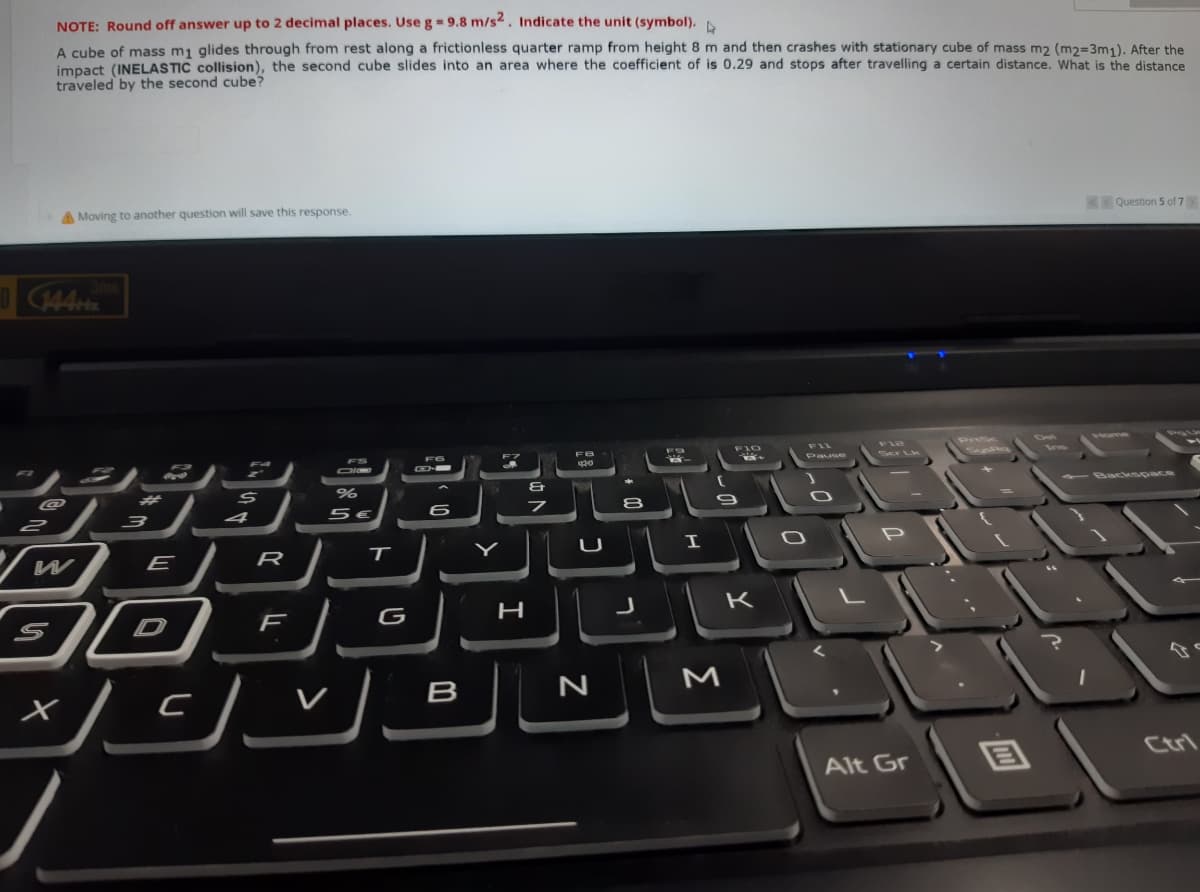NOTE: Round off answer up to 2 decimal places. Use g 9.8 m/s. Indicate the unit (symbol). A cube of mass m1 glides through from rest along a frictionless quarter ramp from height 8 m and then crashes with stationary cube of mass m2 (m2-3m1). After the impact (INELASTIC collision), the second cube slides into an area where the coefficient of is 0.29 and stops after travelling a certain distance. What is the distance traveled by the second cube?
NOTE: Round off answer up to 2 decimal places. Use g 9.8 m/s. Indicate the unit (symbol). A cube of mass m1 glides through from rest along a frictionless quarter ramp from height 8 m and then crashes with stationary cube of mass m2 (m2-3m1). After the impact (INELASTIC collision), the second cube slides into an area where the coefficient of is 0.29 and stops after travelling a certain distance. What is the distance traveled by the second cube?
Principles of Physics: A Calculus-Based Text
5th Edition
ISBN:9781133104261
Author:Raymond A. Serway, John W. Jewett
Publisher:Raymond A. Serway, John W. Jewett
Chapter8: Momentum And Collisions
Section: Chapter Questions
Problem 52P
Related questions
Question

Transcribed Image Text:NOTE: Round off answer up to 2 decimal places. Use g= 9.8 m/s2. Indicate the unit (symbol).
A cube of mass m1 glides through from rest along a frictionless quarter ramp from height 8 m and then crashes with stationary cube of mass m2 (m2=3m1). After the
impact (INELASTIC collision), the second cube slides into an area where the coefficient of is 0.29 and stops after travelling a certain distance. What is the distance
traveled by the second cube?
A Moving to another question will save this response.
Question 5 of 7
144
F6
FIL
Prisc
D
Home
Ser Lk
Ins
Pause
@
#3
Backspace
4
W
E
R
U
H
K
V
B
M
Ctrl
Alt Gr
ט
Expert Solution
This question has been solved!
Explore an expertly crafted, step-by-step solution for a thorough understanding of key concepts.
Step by step
Solved in 3 steps with 3 images

Knowledge Booster
Learn more about
Need a deep-dive on the concept behind this application? Look no further. Learn more about this topic, physics and related others by exploring similar questions and additional content below.Recommended textbooks for you

Principles of Physics: A Calculus-Based Text
Physics
ISBN:
9781133104261
Author:
Raymond A. Serway, John W. Jewett
Publisher:
Cengage Learning

Physics for Scientists and Engineers: Foundations…
Physics
ISBN:
9781133939146
Author:
Katz, Debora M.
Publisher:
Cengage Learning

Physics for Scientists and Engineers
Physics
ISBN:
9781337553278
Author:
Raymond A. Serway, John W. Jewett
Publisher:
Cengage Learning

Principles of Physics: A Calculus-Based Text
Physics
ISBN:
9781133104261
Author:
Raymond A. Serway, John W. Jewett
Publisher:
Cengage Learning

Physics for Scientists and Engineers: Foundations…
Physics
ISBN:
9781133939146
Author:
Katz, Debora M.
Publisher:
Cengage Learning

Physics for Scientists and Engineers
Physics
ISBN:
9781337553278
Author:
Raymond A. Serway, John W. Jewett
Publisher:
Cengage Learning

Physics for Scientists and Engineers with Modern …
Physics
ISBN:
9781337553292
Author:
Raymond A. Serway, John W. Jewett
Publisher:
Cengage Learning

College Physics
Physics
ISBN:
9781285737027
Author:
Raymond A. Serway, Chris Vuille
Publisher:
Cengage Learning

University Physics Volume 1
Physics
ISBN:
9781938168277
Author:
William Moebs, Samuel J. Ling, Jeff Sanny
Publisher:
OpenStax - Rice University